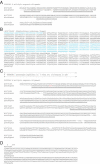PAL2NAL: robust conversion of protein sequence alignments into the corresponding codon alignments
- PMID: 16845082
- PMCID: PMC1538804
- DOI: 10.1093/nar/gkl315
PAL2NAL: robust conversion of protein sequence alignments into the corresponding codon alignments
Abstract
PAL2NAL is a web server that constructs a multiple codon alignment from the corresponding aligned protein sequences. Such codon alignments can be used to evaluate the type and rate of nucleotide substitutions in coding DNA for a wide range of evolutionary analyses, such as the identification of levels of selective constraint acting on genes, or to perform DNA-based phylogenetic studies. The server takes a protein sequence alignment and the corresponding DNA sequences as input. In contrast to other existing applications, this server is able to construct codon alignments even if the input DNA sequence has mismatches with the input protein sequence, or contains untranslated regions and polyA tails. The server can also deal with frame shifts and inframe stop codons in the input models, and is thus suitable for the analysis of pseudogenes. Another distinct feature is that the user can specify a subregion of the input alignment in order to specifically analyze functional domains or exons of interest. The PAL2NAL server is available at http://www.bork.embl.de/pal2nal.
Figures

References
-
- Miyata T., Yasunaga T. Molecular evolution of mRNA: a method for estimating evolutionary rates of synonymous and amino acid substitutions from homologous nucleotide sequences and its application. J. Mol. Evol. 1980;16:23–36. - PubMed
-
- Yang Z. PAML: a program package for phylogenetic analysis by maximum likelihood. Comput. Appl. Biosci. 1997;13:555–556. - PubMed
Publication types
MeSH terms
Substances
LinkOut - more resources
Full Text Sources
Other Literature Sources

